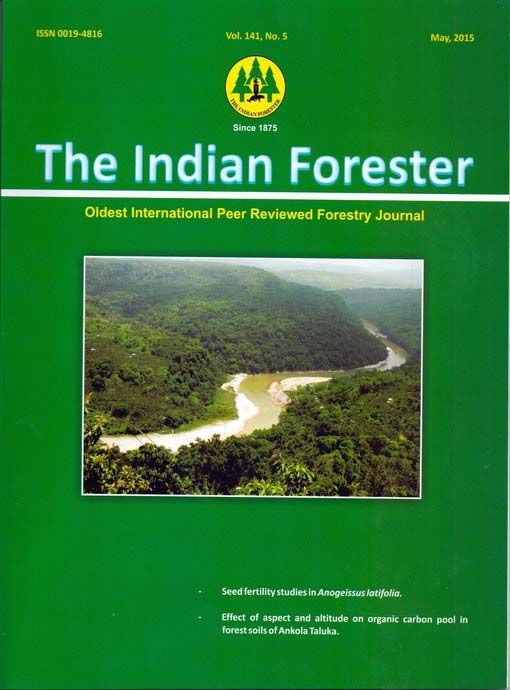Variability Estimate of Growth and Physiological Parameters among Commercially Important Tree Willows
DOI:
https://doi.org/10.36808/if/2015/v141i5/70228Keywords:
Salix, Photosynthesis, Transpiration Wuei, Heritability, Genetic Gains And Genetic Correlation.Abstract
Twenty-three tree willow clones comprising of seven species were studied for variability of photosynthetic traits and their relationship at one year age. Photosynthesis, transpiration and instantaneous water use efficiency (WUEi) were determined and the data were further subjected for the estimation of genotypic and phenotypic coefficient of variability (GCV and PCV), heritability and genetic gain (as per cent of mean). Variability estimates were calculated for growth parameters viz., height, collar diameter, volume index, number of branches, number of nodes, internodal length, leaf display and leaf area. Among all the parameters volume index showed widest range of values (9.29-721.50, mean 356.42). The narrowest range was recorded for leaf display (195.0-291.0, mean 238.17). The maximum GCV (39.99) was recorded for transpiration, followed by photosynthesis (38.36) and least in case of WUEi (19.71). Heritability (h2 b.s.) was recorded maximum (85.30) for transpiration, (80.00) for photosynthesis and (26.55) for WUEi. A positive significant correlation (r= 0.754) was observed between photosynthesis and transpiration. WUEi showed significant negative correlation (r = -0.364) with transpiration whereas positive non significant (r = 0.209) with photosynthesis. Selection of both traits i.e. photosynthesis rate and WUE are important in order to make photosynthesis more effective using water efficiently to produce higher yield.References
Allard R.W. (1960). Principles of Plant Breeding. New York: John Wiley and Sons Inc., 485 p.
Barigah T.S., Saugier B., Mousseau M., Guittet J. and Ceulemans R. (1994). Photosynthesis, leaf area and productivity of 5 poplar clones during their establishment year. Ann. Sci. For., 51: 613-625.
Blake T.J., Tschaplinski T.J. and Eastham A. (1984). Stomatal control of water use efficiency in poplar clones and hybrids. Can. J. Bot., 62: 1344-1351
Burton G.W. and DeVane E.W. (1953). Estimating heritability in tall Fescue (Festuca aurandineae) from replicated clonal material. Agron. J., 1:78-81
Cerrillo T. (2000). A willow breeding programme for timber and paper industry. 21st I.P.C. Oregon, USA.
Ceulemans R. and Impens I. (1980). Leaf gas exchange processes and related characteristics of seven poplar clones under laboratory conditions. Can. J. For. Res., 18: 429-435
Ceulemans R. and Impens I. (1983). Net CO exchange rate and shoot growth of young poplar (Populus) clones. J. Expt. Bot., 34: 866-870 2
Ceulemans R. and Saugier B. (1991). Photosynthesis. In: Physiology of trees (Raghavenara, A.S. ed.), New York. John Wiley and Sons, New York, Inc. pp. 21-50
Choudhary P., Singh N.B., Thakur I.K., Sharma J.P., Sharma A. and Verma A. (2011). Phenological Behaviour and Reproductive Biology of Important Fast Growing Salix Species. Indian J. Ecol., 38: 99-106th Desch H.E. and Dinwoodie J.M. (1996). Timber: structure, properties, conversion and use. 7 ed. Houndmills: McMillan Press. 306 p.
Golz H.L. and Lima W.P. (1997). The ecophysiological basis for productivity in the tropics. In: Management of Soil Nutrients and Water in Tropical Plantation Forests. (Nambiar, E.K.S. and Brown, A.G. (eds.). Canberra: ACIAR, Australia, pp. 213-243
Isebrands J.G., Ceulemans R. and Wiard B.M. (1988). Genetic variation in photosynthetic traits among Populus clones in relation to yield. Plant Physiol. Biochem., 26: 427-437
Johnson H.W., Robinson H.F. and Comstock R.E. (1955). Estimates of genetic and environmental variability in soybean. Agron. J., 47:314-318.
Kramer P.J. and Kozlowski (1979). Physiology of wood and plants. New York: Academic Press. 811 p.
Ledig F.T. (1976). Physiological genetics, photosynthesis and growth model. In: Tree Physiology and Yield Improvement Cannell, M.G.R. and Last, F.T. (eds.). New York: Academic Press. pp. 21-54.
LUSH J. C. (1937). Animal breeding plans. Iowa State College Press. Ames. Iowa.
McDonald J., Lohammar T. and Linder S. (1981). Effect of leaf nitrogen content on CO exchange in a number of Salix clones. Energy For. Tech. 2 Rept. 16, Swedish University of Agricultural Sciences, Uppsala.
Orlovic S., Guzina V., Kristic B. and Merkulov L. (1998). Genetic variability in anatomical.physiological and growth characteristics of hybird poplar
(Populus X euramericana Dode (uuinier)) and eastern cottonwood (Populus deltoides Barth) clones. Silvae Genet., 47(4):183-190.
Pan M., Tu Z., Qun G. and Wang B. (2000). The potential of willow genetic improvement. 21 IPC, 2000
Panse V.G. and Sukhatme P.V. (1967) Statistical Methods for Agricultural Workers. ICAR, New Delhi, 610 p.
Patton L. and Jones M.B. (1989). Some relationship between leaf anatomy and photosynthetic characteristics of Willows. New Phytologist, 111(4): 657-661
Pelkonen P. (1984). Carbon dioxide exchange in willow clones. In: Ecology and management of forest biomass production system. (Pettu, K. (ed.). Dept. Ecol. And Environ. Res., Swedish University of Agricultural Sciences. Report, 15:187-196.
Pillai S.K. and Sinha H.C. (1968). Statistical methods for biological workers. Agra: Ram Prasad and Sons., 259 p.
Stott K.G. (1984). Improving the biomass potential of willow by selection and breeding. In: Ecology and Management of Forest Biomass Production System. Perttu, K. (ed.). Uppsala: Swedish University of Agricultural Sciences, Department of Ecology and Environmental Research, 15: 233-260
Tschaplinski T.J. and Blake T.J. (1989). Correlation between early root production, carbohydrate metabolism and subsequent biomass production in hybrid poplar. Can. J. Bot., 67: 2168-2174
Wang B.S. and Pan M. J. (2000). Study on willow tolerance to water stress 21st I.P.C. Drejon, USA.
Weih M. (2001). Evidence for increased sensitivity to nutrient and water stress in fast growing hybrid willow compared with natural willow clone. Tree Physiology, 21: 1141-1148
Weih M. and Nordh N.E. (2002). Characterising willows for biomass and phytoremediation: growth, nitrogen and water use of 14 willow clones under different irrigation and fertilization regimes. Biomass and Bioenergy, 236:397-413.
Zsuffa L., Sennerby-Forse L., Weisgerber H. and Hall R.B. (1993). Strategies for clonal forestry with poplars, aspen and willows. In:
Conservation and Application. Ahuja, M.R. and Libby, W.J. eds. Clonal Forestry. II. Berlin: Spinger-Verlag, pp. 91-119.
Downloads
Downloads
Published
How to Cite
Issue
Section
License
Unless otherwise stated, copyright or similar rights in all materials presented on the site, including graphical images, are owned by Indian Forester.





